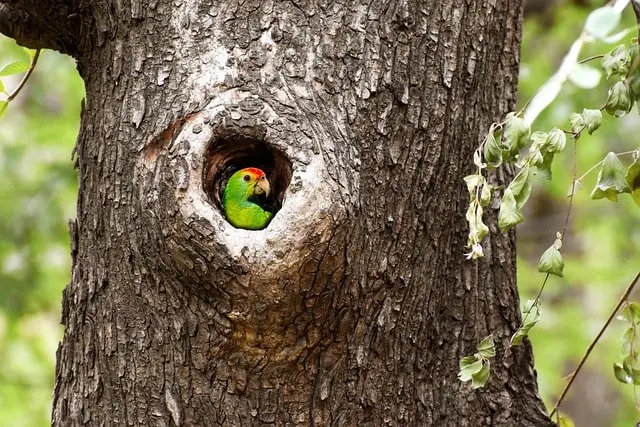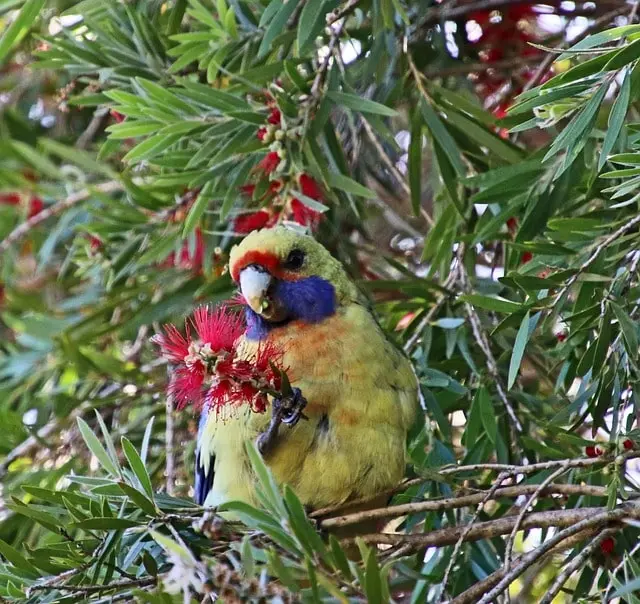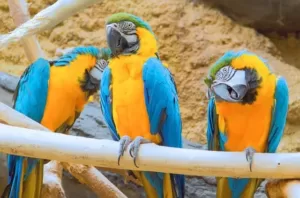Colorful, majestic, and intelligent, parrots are special creatures of the avian world. They are known for their exceptional talking ability, social nature, and lively personalities, which make them great pets. However, there is so much more to parrots than meets the eye.
Parrots are fascinating creatures with many traits and characteristics unique to them. In this article, we have put together 18 fascinating facts about parrots to help you know these birds better.
Facts About Parrots
Quick Navigation
Parrots Produce A Pigment Called Psittacofulvin
Arguably one of the most fascinating things about parrots is how they produce their vivid and diverse feather colors. Birds use carotenoid pigments to make the yellow, orange, and red colors in their feathers. Carotenoids are a widely available pigment obtained from fruits, plants, and animals.
However, unlike other birds, parrots locally synthesize and use a unique pigment called psittacofulvins. These pigments are similar to carotenoids and contribute to the red, orange, or yellow colors seen in the feathers of parrots.
In a study published by Science Direct, researchers studied five parrot species to understand why their bodies chose to use psittacofulvins over carotenoids.
During the growth of the feathers, parrots had both psittacofulvins and carotenoids in their blood. However, the results of the study suggest that parrots can use carotenoids for plumage pigmentation, but avoid depositing them in feathers.
Most Parrots Are Sexually Monomorphic
In most parrot species, the males and females have similar or identical appearances and cannot be distinguished sexually based on physical features. According to PBS, 75 percent of all parrot species are classified as sexually monomorphic.
Of the few parrots that are sexually dimorphic, the difference between them can range widely. Some parrots have the most subtle differences like the white cockatoos, where the male and white cockatoos have different eye colors but the rest of their appearance is identical.
On the other hand, the electus parrot has completely different plumage colors. The difference between the male and female eclectus was so striking that when it was first discovered, aviculturists thought they were two different species.
However, the majority of parrots lack such differences, which makes it challenging to know their gender. Unless the parrots are sexually dimorphic, they can only be sexed by DNA testing.
Parrots Are Socially Monogamous
When a male and female parrot pairs up, they usually stay together for at least one breeding season. Parrots follow what is known as social monogamy.
This means that parrots are monogamous but they do not always mate for life. Cheating is also quite common in the parrot kingdom. Parrots switch partners if they are not compatible or they cannot successfully breed.
Parrots Do Not Build Their Own Nests
Unlike other birds, parrots do not build their own nests. Instead, they occupy already existing ones. Parrots are secondary cavity-nesters, meaning they do not build their own nest and rely on primary cavity nesters to excavate nesting sites.
Hummingbirds are a common primary cavity-nesting bird that usually excavates more nesting sites in one breeding season than it needs. Once these birds leave their nesting site, parrots move into them to breed and raise their chicks.
However, tree hollows are not the only cavity that breeding parrots reside in. The rosy-faced lovebird nests in giant saguaro cactuses in Phoenix, Arizona. These cactuses are also hollowed out by hummingbirds.
Some parrot species also nest in termite mounds. When the termite mounds are constructed, parrots dig holes into them to carve out a cavity for them.

Parrots Can Dance
Parrots are one of the few animals that can dance. They can distinguish between different types of music and even have preferences for certain genres or songs.
Parrot dance typically involves swaying and a lot of head bobbing. But that does not mean they do not have other dance moves. Snowball, a male Eleonora cockatoo is known for having 14 distinct dance moves.
For us humans dancing and enjoying music is pretty natural, but this ability is rare in animals. According to Frontiers in Psychology, apart from parrots, there is limited scientific evidence for beat and regularity perception among birds.
Parrots Have About 300 Taste Buds
Compared to us, the taste receptors in a parrot’s mouth are far less developed. Parrots only have around 300 taste buds that are located on the roof of their mouth. They are able to detect flavors including sweet, sour, bitter, and salty.
Their perception of taste is much better than any other avian species. This is the reason why parrots show individual preferences for certain tastes and have their own favorite snacks.
Parrots Breed Once A Year
Most parrots, especially the larger ones only breed once a year. The breeding season for parrots arrives usually in spring when the temperatures are warm, there’s abundant food and other environmental factors are suitable for raising chicks.
Parrots have a slow breeding cycle, which is part of the reason why their species population numbers are low. Parrots fall into the category of K-selected species. K-selected species are characterized by slow maturation, a small number of offspring, extended parental care, and long life spans.
Parrots Are Long-Lived Birds
Unlike other popular pets, parrots live a long life, even outliving their owners. Large parrot species like macaws, African grey, and cockatoos tend to live over 50 years.
According to Guinness World Records, the oldest parrot ever was a Major Mitchell’s cockatoo named Cookie. The parrot was 82 years and 88 days old when he passed away.
Many Parrot Species Are Facing Extinction Risk
Parrot populations worldwide are on a decline and a large number of species face the risk of extinction. There are many reasons for this situation. Habitat loss is one of the concerns as deforestation and urbanization reduce the availability of suitable living areas for parrots.
Parrots are also under threat by Illegal wildlife trade. Parrots that are sought after as pets are over-captured for the pet trade, leading to population declines. Also, as mentioned, parrots have slow reproductive rates, which makes it challenging for populations to recover quickly from these threats.
According to Research Gate, 28% of parrot species are considered threatened by the IUCN. 111 of the world’s parrot species out of the approximately 398 are classified as vulnerable, endangered, or critically endangered by the IUCN Red List.
Most Parrots Are Left-Footed
Just like us, parrots also have a dominant foot that they use most often. A study by Biology Letters learned about the foot preference in 16 different species of Australian parrots.
It was found that approximately 47 percent of the parrots were left-handed, 33 percent were right-handed and the rest were ambidextrous. There have been several other studies on foot preference in parrots and a majority of parrots prefer to use their left foot.
Parrots Are Omnivores
Most parrots are omnivores, which means they eat both plant and animal-based foods. Wild parrots have a diverse diet that includes fruits, seeds, nuts, flowers worms, and insects.
Although they eat meat, it makes up a small portion of their diet. Also, they usually eat insects while they are foraging in the grass. Parrots do not eat dead animal meat in the wild like other predatory birds do.
However, there are a few species like the lorikeets that are frugivores and feed primarily on fruits and nectar from flowers.

The Smartest Parrot Has The Intelligence Level Of A 5 Year Old
The African Grey is considered to be the smartest parrot in the world. Numerous studies have demonstrated its intelligence in the areas of problem-solving, spatial awareness, and deductive reasoning.
According to The Harvard Gazette, African Greys can pass the classic test of intelligence along with a more advanced version of it, surpassing the intelligence of a 5-year-old.
Researchers of this study conducted the traditional two-cup test used to test animal cognition, but further included more complex three- and four-cup tasks.
The classic two-cup test involves hiding a reward in one of two cups, and subjects choosing the other cup after seeing one is empty. Griffin, an African grey parrot, excelled in the traditional as well as the advanced tests, outperforming 5-year-old children.
Parrots Can Imitate Sounds
Parrots are one of the few species on the planet that can imitate virtually any sound with precision, including human speech. They are able to speak human words with the same level of eloquence. Not only that, parrots have also been seen imitating other animal noises such as a dog’s bark and a cat’s meow.
A Group Of Parrots Is Called A Pandemonium
A group of parrots is called a pandemonium. The meaning of the word pandemonium is “wild uproar or noise”, which aptly represents a group of parrots because they can be noisy, and chaotic.
The Kākāpō Parrot Cannot Fly
Also known as the night parrot or owl parrot, the Kākāpō is the only flightless parrot in the world. It is a critically endangered species of parrot native to New Zealand. (Source: Wikipedia)
Zygodactyl Feet
Parrot feet have four toes with two toes facing forward and two toes facing backward. This is different from most birds who have three toes in front and one at the back. This arrangement allows for better grip and handling of objects.
Parrots Eat With Their Feet
Parrots are incredibly dexterous when it comes to using their feet for various kinds of activities including grasping and holding objects. Parrots use their feet to hold and manipulate their food while they eat it.
They bring the food to their beaks using their feet, much like how we use our hands to pick up food and eat. The structure and dexterity of their feet, help them to handle foods of all sizes very efficiently.
Parrots Beak Is Always Growing
Parrot beaks are continuously growing as they are composed of keratin, the same protein that fingernails are made of.
In order to keep the beaks in shape and proper length, parrots engage in activities like rubbing their beaks against tree branches or hard surfaces. This helps wear down the outer layer of the beak, preventing it from becoming too long.
This is also the reason why you wouldn’t find a parrot with a perfectly smooth beak. Parrot beaks are always a little coarse because the outer layer is constantly being replaced with new keratin material.







